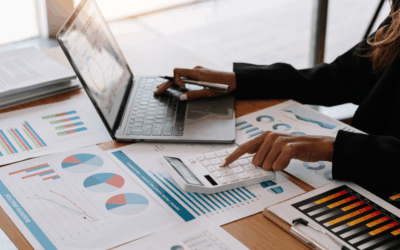Understanding financial jargon is critical for running a successful business. Terms like “amortization” and “depreciation” frequently arise in discussions about assets and their worth over time. As perplexing as they may appear, understanding these variances can reveal valuable insights into your company’s financial health.
What is Amortization?
In accounting, amortization refers to the gradual reduction of any amount over a predetermined period. This term commonly applies to intangible assets such as patents or trademarks, goodwill from an acquisition, lease agreements, or expenditure on research and development.
Although formless, intangible assets are valuable economic resources with lifetimes that span several years. Like tangible assets, accountants allocate their costs across their lifespan. This allocation process is known as amortization. Amortization spreads out the expense related to an intangible asset through each accounting period of its lifetime.
Methods of Amortization
Straight-line or linear amortization is the most widely adopted method of amortizing an intangible asset. The asset’s cost is divided equally over its estimated useful life, resulting in a consistent annual charge until its value depreciates to zero.
Another standard method is a decreasing balance approach, in which more significant amounts incurred in earlier quarters gradually decrease over time.
Finally, there is the sinking fund strategy, in which equal recurring payments are compounded annually at a set interest rate. This strategyallows the fund to develop into an accumulated sum equal to the asset’s initial cost once its useful life has ended.
This concept might feel overwhelming initially but don’t worry: With practice and appropriate application, you’ll start appreciating it more than ever!
What is Depreciation?
Assume your company possesses manufacturing equipment or a fleet of cars. These are examples of “tangible assets,” or physical items that contribute to the production or services provided by your organization. Depreciation is the loss in value that tangible assets endure over their lifetime due to factors like use, damage, or obsolescence.
Although these devices are helpful for your operations, they will naturally age and become less effective with time. Depreciation demonstrates that accounting standards acknowledge that continuous use affects equipment effectiveness.
Methods of Depreciation
Many businesses adopt multiple approaches to account for depreciation, covering various scenarios. Here’s a brief overview:
- Straight-Line Method: This method’s simplicity makes it widely popular among businesses. It divides the total cost of the asset evenly over its estimated useful lifespan.
- Double Declining Balance Method: This technique enables companies torecord more significant depreciation rates during the initial years after an asset purchase than later.
- Units-of-production Method: This method is ideal in cases where outputs directly relate to usage, such as miles driven in vehicles, rather than simply time passed.
Choosing an appropriate method depends heavily upon individual circumstances and the nature of operations within an organization.
Critical Differences Between Amortization and Depreciation
Understanding financial terminology can be daunting, especially regarding amortization and depreciation. At first glance, amortization and depreciation may appear similar, as they both involve spreading costs over time.
However, the distinction lies in the types of assets they address. Depreciation regards tangible assets with a physical presence, such as machinery and buildings. In contrast, amortization pertains to intangible assets like patents or trademarks, which lack a physical form.
Another differentiating factor is their valuation methods. While depreciation can utilize various approaches like straight-line or declining balance methods, amortization typically employs a straightforward straight-line method.
Moreover, the tax treatments for these two processes can vary, impacting a company’s financial obligations and potential benefits. Understanding these differences is vital for making informed financial decisions and maximizing tax advantages.
Furthermore, it’s essential to consider how depreciation and amortization affect a company’s balance sheet and profit projections. Selecting the appropriate method based on circumstances can significantly influence your business’s financial health and bottom line.
In summary, while depreciation and amortization spread costs over time, their distinct applications, valuation methods, tax implications, and financial statement impacts set them apart.
The Impact of Amortization and Depreciation on Financial Statements
Understanding the impact of amortization and depreciation on financial statements is vital for managing your business. These methods spread investment costs over time, significantly influencing your financial reports. Both amortization and depreciation are recorded as expenses on the income statement, affecting profitability and equity within the balance sheet.
Depreciation decreases the book value of tangible assets like machinery and buildings. In contrast, amortization pertains to intangible assets like patents and trademarks, not directly impacting current period equity or liabilities. Instead, it relates to long-term debt items.
These entries also affect EBITDA (Earnings Before Interest, Taxes, Depreciation, and Amortization). EBITDA equals net income plus taxes, interest expense, depreciation, and amortization. This calculation shows how these expenses influence overall financial performance.
Despite their similarities, amortization and depreciation have distinct impacts on financial statements. Remember that depreciation decreases tangible asset values, while amortization focuses on intangible assets and long-term debts. Both methods help in cost recovery but alter financial landscapes in different ways.
Don’t worry if this seems complex. With the proper understanding and tools, navigating these impacts becomes manageable. We will cover solutions to simplify this process, ensuring you can confidently handle financial statements.
Our Practical Tips for Managing Amortization vs. Depreciation
Understanding the intricacies of amortization vs depreciation is vital to effectively managing your business finances. Accurate depreciation and amortization calculations can significantly influence your company’s financial health, impacting operations, profitability, taxation, and business valuation. Here are three practical tips on handling both these facets wisely:
Choosing the Right Amortization and Depreciation Methods
Selecting the proper depreciation or amortization method is crucial for accurate asset management. The option you choose depends mainly on the nature of the asset. The Straight-Line Method suits most assets and situations, allowing an asset to depreciate evenly over its useful life.
Each method affects tax deductions and net income differently at year-end, influencing cash flow and profits. Understanding these nuances will help you make the best decisions for your business. By selecting the appropriate method, you ensure accurate financial reporting and optimize your company’s financial health.
Maintaining Detailed and Accurate Records with Bookkeeping Software
Using reliable bookkeeping software simplifies complex accounting tasks, like deciding between amortization and depreciation for certain assets. These tools automate calculations, reducing errors and saving your time.
Choose bookkeeping software that offers:
- Comprehensive support for various depreciation and amortization methods
- Error-proof calculation algorithms
- Capability to adjust to changes in tax laws
- Seamless integration with your existing accounting system
Regularly Reviewing and Adjusting Asset Values
Auditing your assets’ current market and book values is essential. Fluctuations in these values may require adjustments in depreciation or amortization rates.
For instance, if inflation causes market prices to rise, using older depreciation rates might undervalue your assets. Regular reviews help balance this misalignment and ensure accuracy. By keeping asset values up to date, you maintain accurate financial statements and better reflect your company’s financial position.
Manage Amortization, Depreciation, and Other Accounting Needs With Remote Quality Bookkeeping
Mastering concepts like amortization and depreciation can feel overwhelming. You might wonder how to track value reduction properly or differentiate which costs to spread out. These layers of business finance can be complex, but they are manageable with the proper support. By partnering with Remote Quality Bookkeeping, you can more easily unravel complex areas such as amortization and depreciation.
With a cloud-based system, our team provides real-time access to financial data and offers automatic backups to protect critical business information. We integrate seamlessly with your existing accounting system for greater efficiency. Our team ensures your financial records stay accurate, updated, and compliant with regulatory standards. Contact us today to see how we can help optimize your accounting needs and support your business’s financial health.


